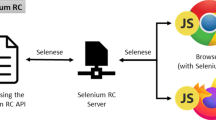Abstract
Many people have been interested in Web 2.0, which is a new concept of Web service. Web sites became sources of information and functionality that enables users to create new content of their own. For this demand, more versatile browsers that enables users to edit and display content based on their creative concepts and preferences are required. Motivated by this demand, we have developed a state-transition diagram-based Web browser programming scheme that supports participatory Web use and enables end-user to interact with Web content. We implemented a prototype of our scheme called GUEST (Graphical User interface Editor by State-transition Diagram). GUEST enables users to define behaviors of a Web browser easily. However, there are some parts of complexity of user interfaces that prevent the users’ intuitive understanding in the original version of GUEST. Therefore, in this paper, we focus on user interface, and introduce a new concept of the design.
Access this chapter
Tax calculation will be finalised at checkout
Purchases are for personal use only
Preview
Unable to display preview. Download preview PDF.
Similar content being viewed by others
References
O’reilly, T.: What Is Web 2.0 (2005), http://www.oreillynet.com/pub/a/oreilly/tim/news/2005/09/30/what-is-web-20.html
Obu, Y., Yamamoto, M., Yonekura, T., Kamada, M., Okamoto, S.: Exploring State-transition diagram-based Web Browser Programming. In: CYBERWORLDS 2007, International Conference on Cyberworlds, Cyberworlds Press (2007)
Okamoto, S., Kamada, M., Nakao, T.: Proposal of an Interactive Animation Authoring Tool Based on State-transition diagram. Information Processing Society of Japan. No.SIG 1(PRO24), vol. 46, pp. 19–27 (2005) (in Japanese)
Okamoto, S., Shimomura, T., Kamada, M., Yonekura, T.: Programming with Islay. An Interactive Animation Authoring Tool, vol. 47, No.SIG 6(PRO29). Information Processing Society of Japan (2006) (in Japanese)
Jacob, R.J.K.: Using Formal Specifications in the Design of a Human-Computer Interface. Communications of the ACM 26(4), 259–264 (1983)
Jacob, R.J.K.: A Specification Language for Direct Manipulation User Interfaces. ACM Transactions on Graphics 5(4), 283–317 (1986)
Harel, D.: Statecharts: A Visual Formalism for Complex Systems. Sci. Compt. Programming (8), 231–274 (1987)
Object Management Group, OMG’S Unified Modeling Language, http://www.omg.org/
Kendall, S.: UML Explained, Pearson Education Japan, 4th edn., Tokyo (2003)
Mozilla org., Mozilla Firefox, http://www.mozilla.jp/firefox/
Greasemonkey, http://greasemonkey.mozdev.org/
Platypus, http://platypus.mozdev.org/
Bolin, M., Webber, M., Rha, P., Wilson, T., Miller, R.C.: Automation and Customization of Rendered Web Pages. In: ACM Conference on User Interface Software and Technology, UIST, pp. 163–172 (2005)
Mozilla Foundation, XUL, http://www.mozilla.org/projects/xul/
World Wide Web Consortium, Resource Description Framework, http://www.w3.org/RDF/
SIMILE Project, http://simile.mit.edu/
Appalachian, http://simile.mit.edu/wiki/Appalachian
Huynh, D., Mazzocchi, S., Karger, D.: Piggy Bank - Experience the Semantic Web Inside Your Web Browser. In: Gil, Y., Motta, E., Benjamins, V.R., Musen, M.A. (eds.) ISWC 2005. LNCS, vol. 3729, pp. 413–430. Springer, Heidelberg (2005)
Timeplot, http://simile-widgets.org/timeplot/
TimeLine, http://simile-widgets.org/timeLine/
Huynh, D., Karger, D., Miller, R.: Exhibit - Lightweight Structured Data Publishing. In: International World Wide Web Conference. ACM, New York (2007) 978-1-59593-654-7/07/0005
Author information
Authors and Affiliations
Editor information
Editors and Affiliations
Rights and permissions
Copyright information
© 2009 Springer-Verlag Berlin Heidelberg
About this paper
Cite this paper
Obu, Y., Maruo, K., Yonekura, T., Kamada, M., Okamoto, S. (2009). State-Transition Diagram for Visual Programming Tool GUEST. In: Cordeiro, J., Hammoudi, S., Filipe, J. (eds) Web Information Systems and Technologies. WEBIST 2008. Lecture Notes in Business Information Processing, vol 18. Springer, Berlin, Heidelberg. https://doi.org/10.1007/978-3-642-01344-7_16
Download citation
DOI: https://doi.org/10.1007/978-3-642-01344-7_16
Publisher Name: Springer, Berlin, Heidelberg
Print ISBN: 978-3-642-01343-0
Online ISBN: 978-3-642-01344-7
eBook Packages: Computer ScienceComputer Science (R0)




